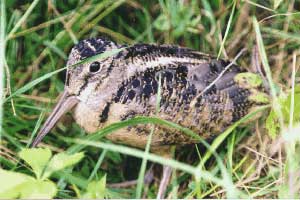Woodcocks
Air Date: Week of May 10, 2002
They’re short, they’re stout, and they’re reclusive as hermits. But when it comes to attracting a mate, the male woodcock pulls out all the stops. Bob Speare, a naturalist at the Massachusetts Audubon Society, takes us on an audio tour of the woodcock’s singing grounds in Ipswich, Massachusetts.
Transcript
You’re listening to NPR’s Living on Earth. Spring is here. And for one small and usually shy bird, love is, literally, in the air. This time every year, the male American Woodcock descends on a grassy spot called a "singing field" and begins a unique courting display.
Bob Speare, a naturalist with the Massachusetts Audubon Society, has been watching this show for years and invited us to join him one evening at the Society sanctuary in Ipswich, Massachusetts.
[SOUND OF WALKING, BIRDS AND INSECT]
SPEARE: Oh, this is going to be a good night. I can feel it. We can hang out right here until it comes in.
A woodcock is kind of a really silly looking bird. It’s a short, stout bird that has a very long bill that it uses to probe into the ground to search for earthworms. It has short, rounded wings. It does have eyes set way back on the top of its head. And it allows the bird to see almost 360° to see what’s going on around it.
(BIRD SOUNDS)

SPEARE: As we’re getting closer to the time that the woodcocks come out, we’re starting to see some of these day birds and other animals kind of punching out for the day and going home.
Once we reach the right candle power of light, we’ll probably first hear one of these animals come in. Their wings give a little twittering sound [he imitates twittering sound] as they fly in to that specific spot on the ground. And once they do, they’ll almost immediately begin with this nasally peent, peent, peent.
[WOODCOCK PEENT]
SPEARE: There it is!
[WOODCOCK PEENT]
SPEARE: And then they’ll burst into the air. And again, you’ll hear that little [he imitates twittering sound] of the wings as they spiral up several hundred feet, or a couple of hundred feet anyway.
[SOUND OF WOODCOCK WING TWITTERING]
SPEARE: There he goes. There he goes. He’s in the air. There he goes. Now he’s descending. He’s kind of free-falling back down, heading back to the same spot. Here he comes. Bang. He’s back on the ground.
[WOODCOCK PEENT]
SPEARE: Exact same spot. Exact same place.
There’s a quality in that display, that the female is probably gauging in her head to realize, "Is this the one for me?" It’s pretty amazing to think that they’ll come out in any kind of weather, and just keep going night after night after night, even though nobody’s interested. It’s very seldom that they actually attract a mate. Yet, they’re out there every single night, doing it over and over and over.
CURWOOD: Naturalist Bob Speare, watching the woodcocks at the Massachusetts Audubon Society Sanctuary in Ipswich, Massachusetts.
Living on Earth wants to hear from you!
Living on Earth
62 Calef Highway, Suite 212
Lee, NH 03861
Telephone: 617-287-4121
E-mail: comments@loe.org
Newsletter [Click here]
Donate to Living on Earth!
Living on Earth is an independent media program and relies entirely on contributions from listeners and institutions supporting public service. Please donate now to preserve an independent environmental voice.
NewsletterLiving on Earth offers a weekly delivery of the show's rundown to your mailbox. Sign up for our newsletter today!
 Sailors For The Sea: Be the change you want to sea.
Sailors For The Sea: Be the change you want to sea.
 The Grantham Foundation for the Protection of the Environment: Committed to protecting and improving the health of the global environment.
The Grantham Foundation for the Protection of the Environment: Committed to protecting and improving the health of the global environment.
 Contribute to Living on Earth and receive, as our gift to you, an archival print of one of Mark Seth Lender's extraordinary wildlife photographs. Follow the link to see Mark's current collection of photographs.
Contribute to Living on Earth and receive, as our gift to you, an archival print of one of Mark Seth Lender's extraordinary wildlife photographs. Follow the link to see Mark's current collection of photographs.
 Buy a signed copy of Mark Seth Lender's book Smeagull the Seagull & support Living on Earth
Buy a signed copy of Mark Seth Lender's book Smeagull the Seagull & support Living on Earth

